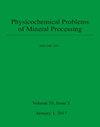Beneficiation Of Artvin-Cerattepe copper-zinc ore by flotation
IF 1.2
4区 工程技术
Q4 CHEMISTRY, PHYSICAL
引用次数: 0
Abstract
The Cerattepe (Artvin) mine contains volcanogenic massive sulfide (VMS) deposits in northeastern Turkey. This is a kuroko type deposit located in Late Cretaceous volcanic, intrusive and sedimentary rocks, and has a structure with dense alteration stages. In this study, batch flotation tests were carried out to determine the flotation behavior of a new sample (mix ore), that was the combination of two different ores with different flotation behaviors. The mixed ore contains 2.18% Cu, 1.46% Zn, (Cu/Zn ratio 1.49) 38.35% Fe, and 41.6% S content. An efficient separation of copper minerals from zinc minerals using the conventional selective flotation method could not be achieved due to complex mineralogy and very low liberation degree. Therefore, sequential selective flotation resulted in poor Cu recovery. The effects of flotation parameters such as collector type, collector amount, particle size, and pH conditions, were investigated to obtain a bulk copper-zinc concentrate. The best results were obtained using thionocarbamate (Aero 3894) and dithiophosphine (Aerophine 3418A) collector reagents at d80=40 µm particle size. Under optimal conditions (grain size, d80=40 µm, pH=11, amount of collector reagent 60 g/t (Aero 3894), frother (MIBC)=50 g/t, solid ratio=32%, flotation time=8 min), a bulk copper-zinc concentrate containing 13% Cu and 9.5% Zn was obtained with a copper yield of 84.4% and a zinc yield of 88.9%. The concentrate mass pull was 13%. After rougher and two-stage scavenger flotation, a concentrate (rougher concentrate + scavenger products) was obtained with a mass pull of 22%. Copper and zinc recoveries of this concentrate were 91.8% and 92.5%, respectively.Artvin Cerattepe铜锌矿石的浮选选矿
Cerattepe(Artvin)矿包含土耳其东北部的火山成因块状硫化物(VMS)矿床。这是一个位于晚白垩世火山岩、侵入岩和沉积岩中的kuroko型矿床,具有致密蚀变阶段的结构。在本研究中,进行了分批浮选试验,以确定一种新样品(混合矿)的浮选行为,即两种具有不同浮选行为的不同矿石的组合。混合矿石中Cu含量2.18%,Zn含量1.46%,(Cu/Zn比1.49)Fe含量38.35%,S含量41.6%。由于复杂的矿物学和极低的释放度,使用传统的选择性浮选方法无法实现铜矿物与锌矿物的有效分离。因此,顺序选择性浮选导致铜回收率低。为了获得大块铜锌精矿,研究了捕收剂类型、捕收剂用量、粒度和pH条件等浮选参数的影响。使用硫代氨基甲酸酯(Aero 3894)和二硫代膦(Aerophine 3418A)捕收剂在d80=40µm粒径下获得最佳结果。在最佳条件下(粒度,d80=40µm,pH=11,捕收剂用量60g/t(Aero3894),起泡剂(MIBC)=50g/t,固形比=32%,浮选时间=8min),获得了含13%铜和9.5%锌的大块铜锌精矿,铜产率为84.4%,锌产率为88.9%。精矿质量拉力为13%。经过粗选和两级清除剂浮选,获得质量拉力为22%的精矿(粗选精矿+清除剂产品)。铜和锌的回收率分别为91.8%和92.5%。
本文章由计算机程序翻译,如有差异,请以英文原文为准。
求助全文
约1分钟内获得全文
求助全文
来源期刊

Physicochemical Problems of Mineral Processing
CHEMISTRY, PHYSICAL-MINING & MINERAL PROCESSING
自引率
6.70%
发文量
99
期刊介绍:
Physicochemical Problems of Mineral Processing is an international, open access journal which covers theoretical approaches and their practical applications in all aspects of mineral processing and extractive metallurgy.
Criteria for publication in the Physicochemical Problems of Mineral Processing journal are novelty, quality and current interest. Manuscripts which only make routine use of minor extensions to well established methodologies are not appropriate for the journal.
Topics of interest
Analytical techniques and applied mineralogy
Computer applications
Comminution, classification and sorting
Froth flotation
Solid-liquid separation
Gravity concentration
Magnetic and electric separation
Hydro and biohydrometallurgy
Extractive metallurgy
Recycling and mineral wastes
Environmental aspects of mineral processing
and other mineral processing related subjects.
 求助内容:
求助内容: 应助结果提醒方式:
应助结果提醒方式:


